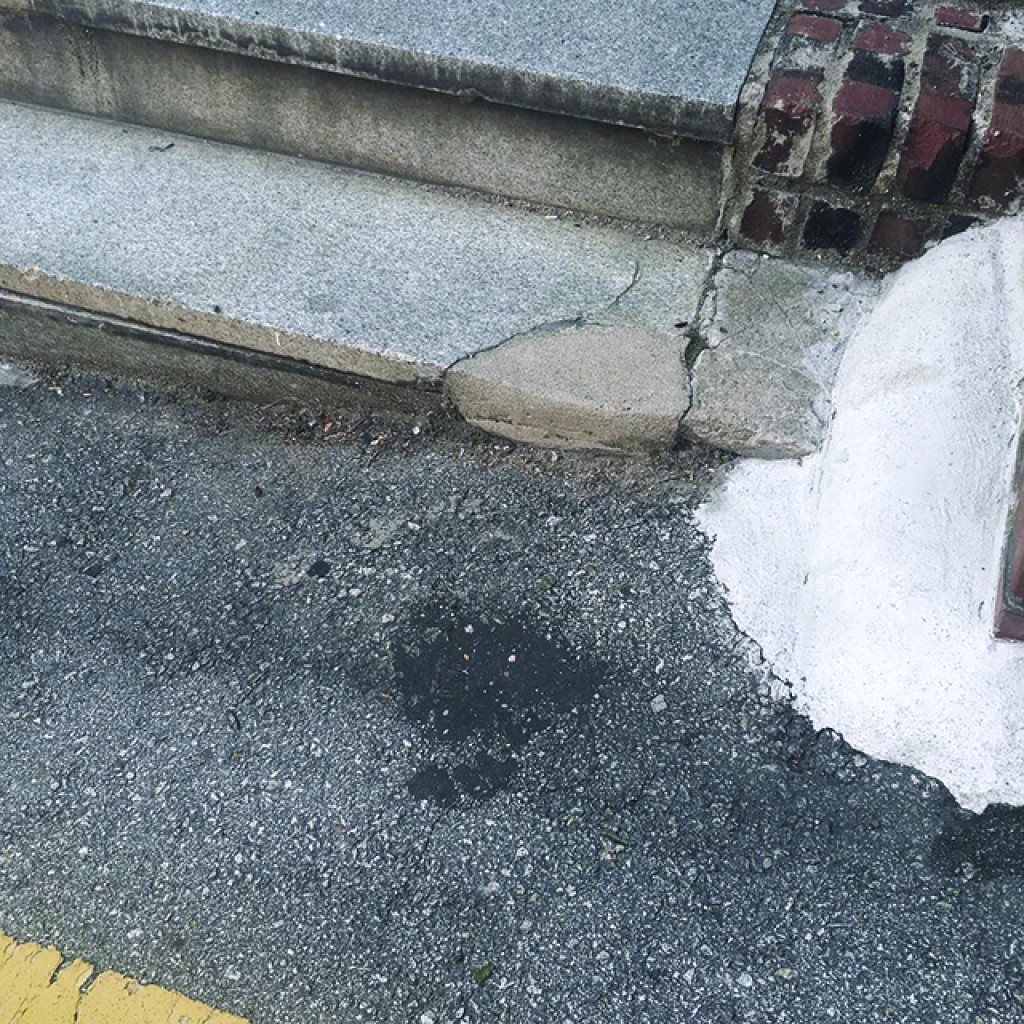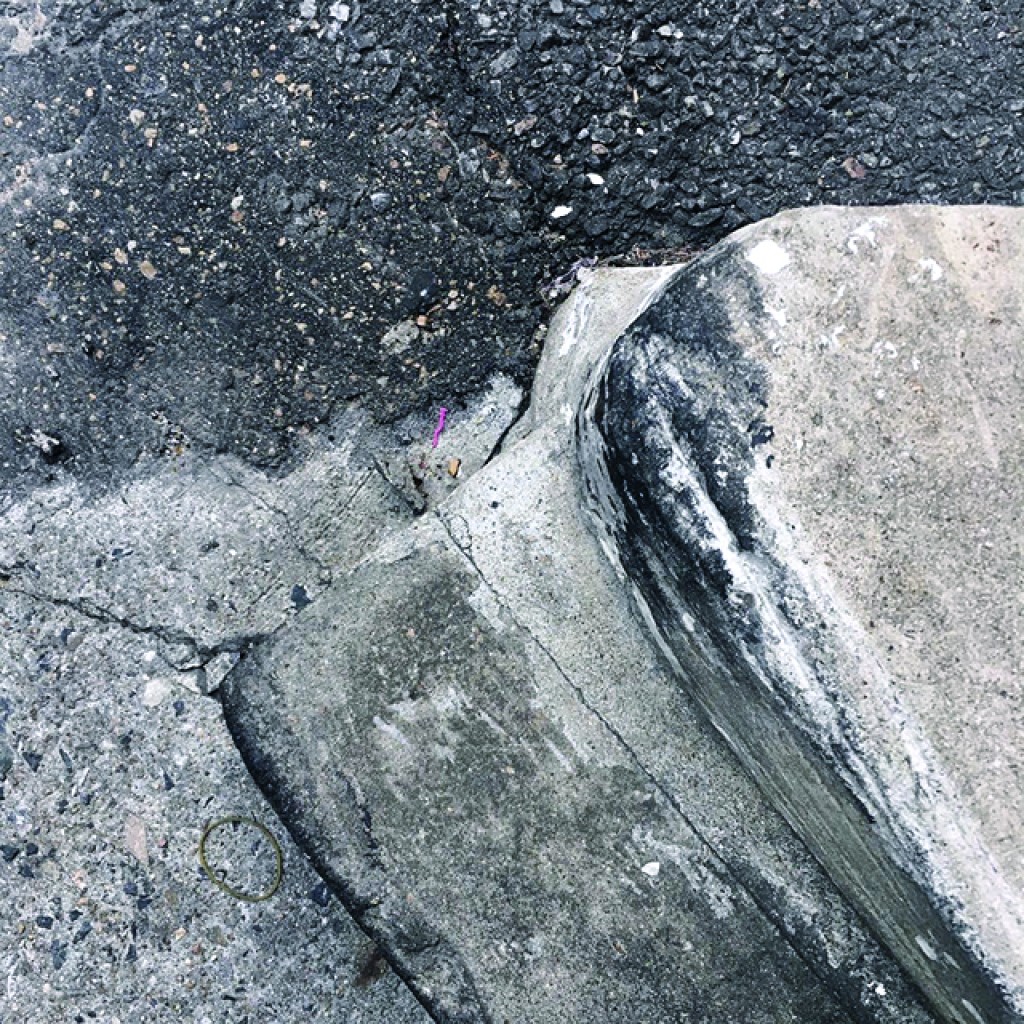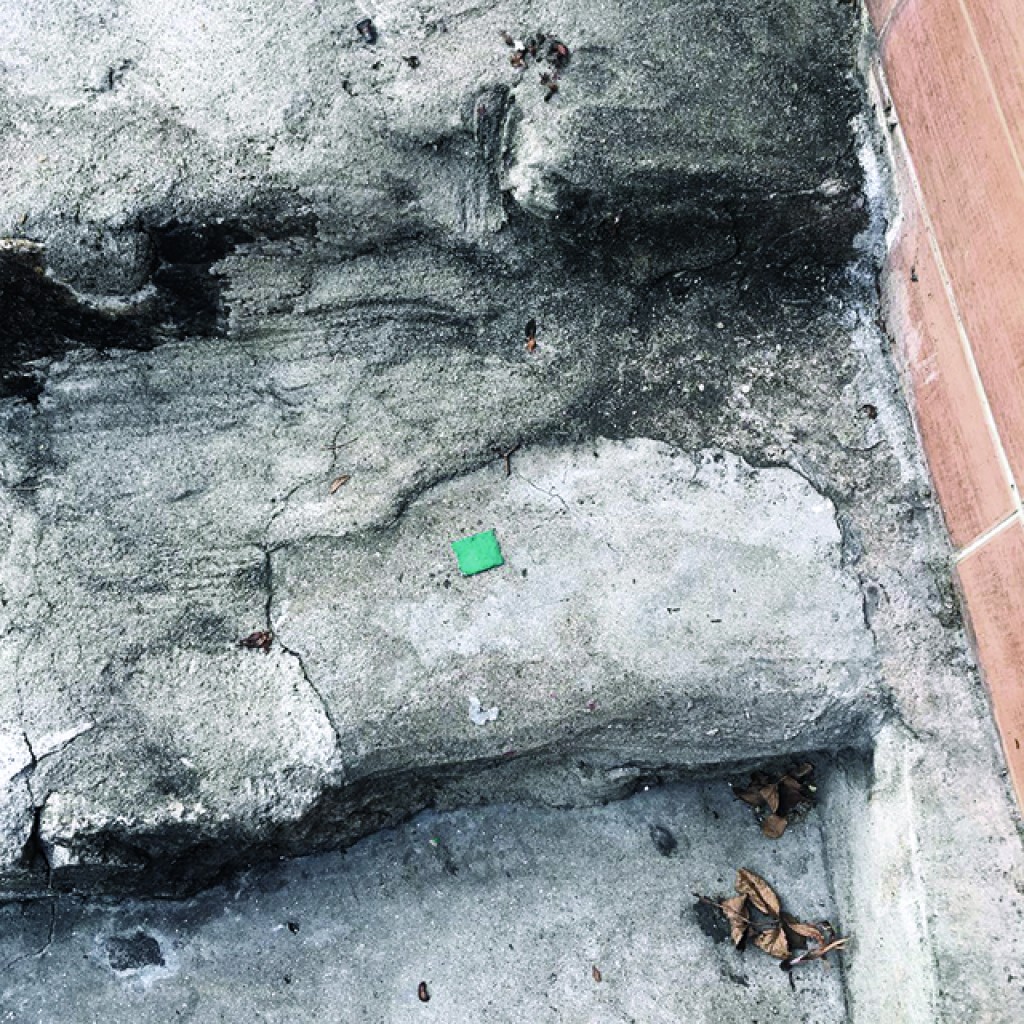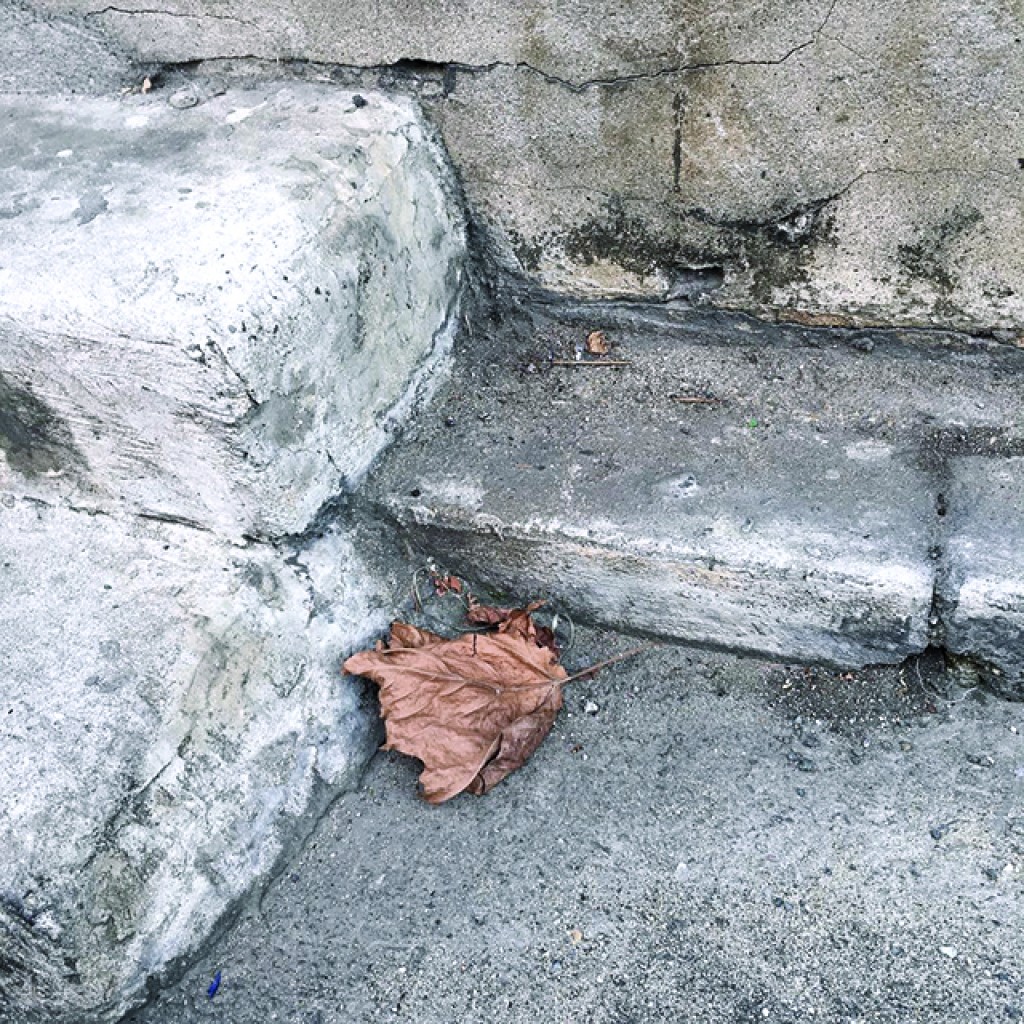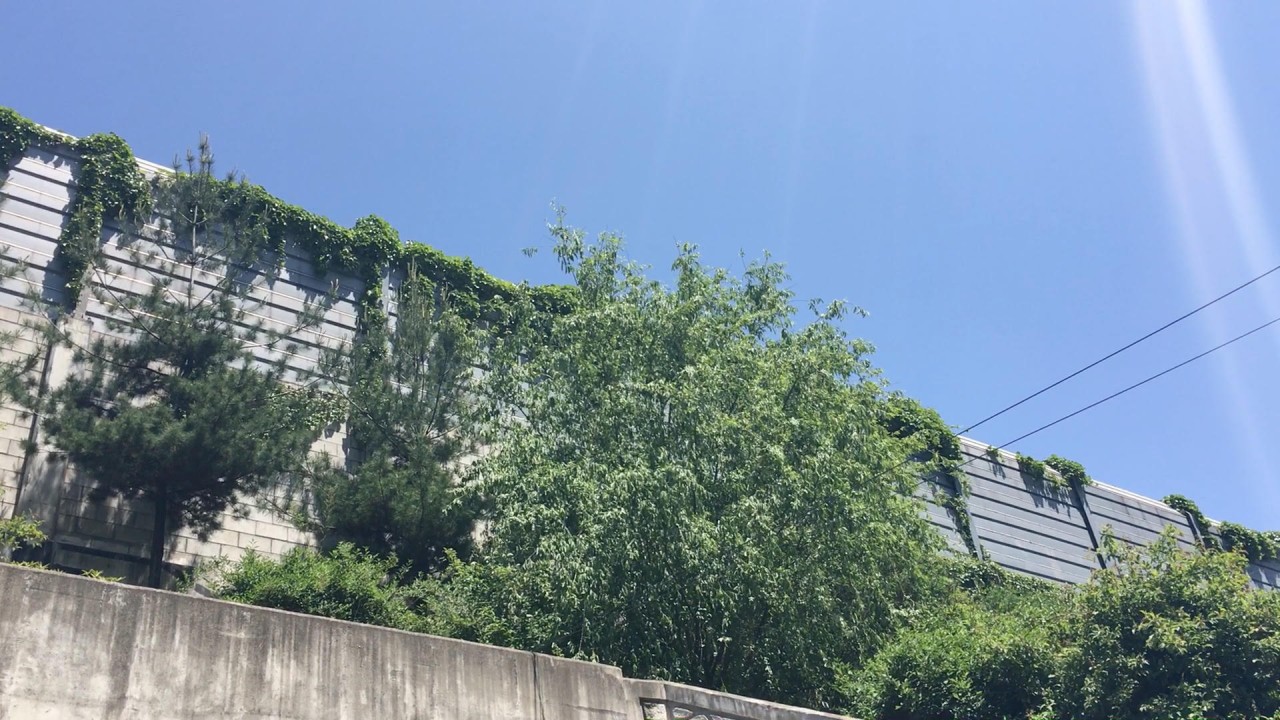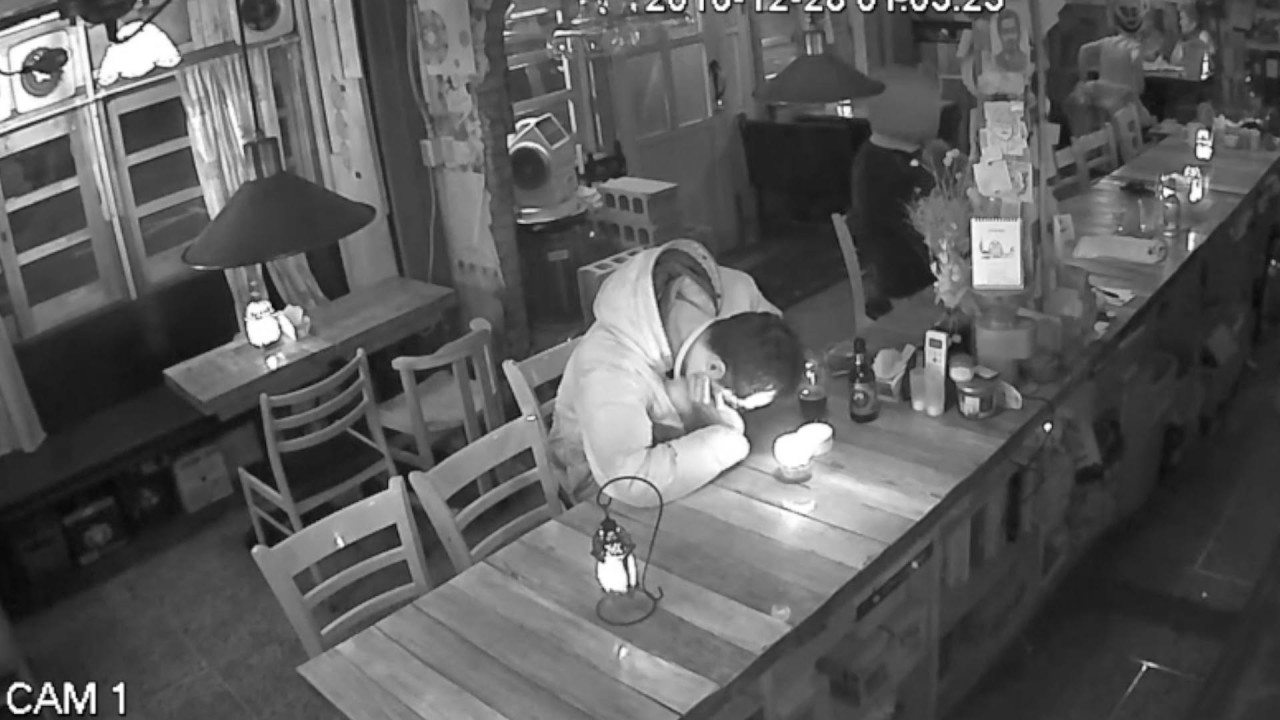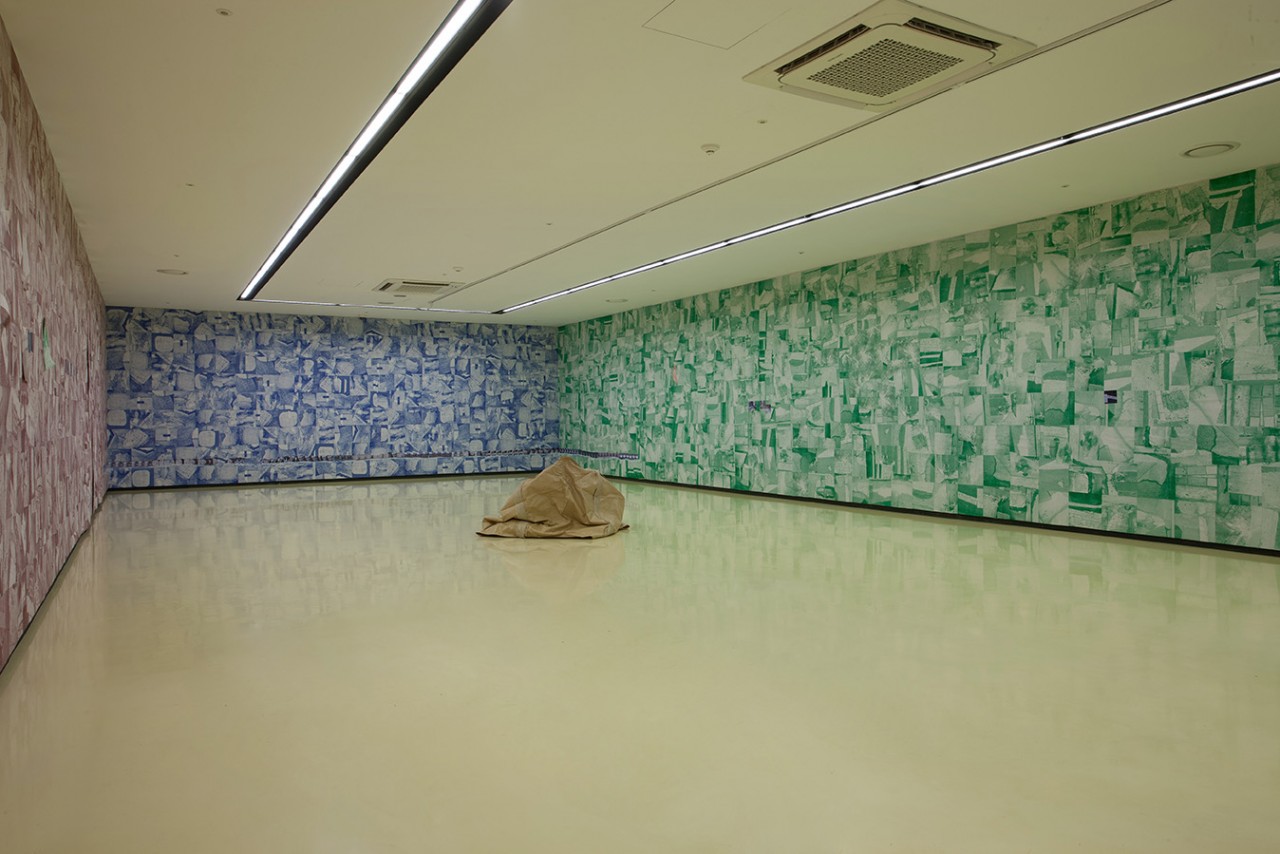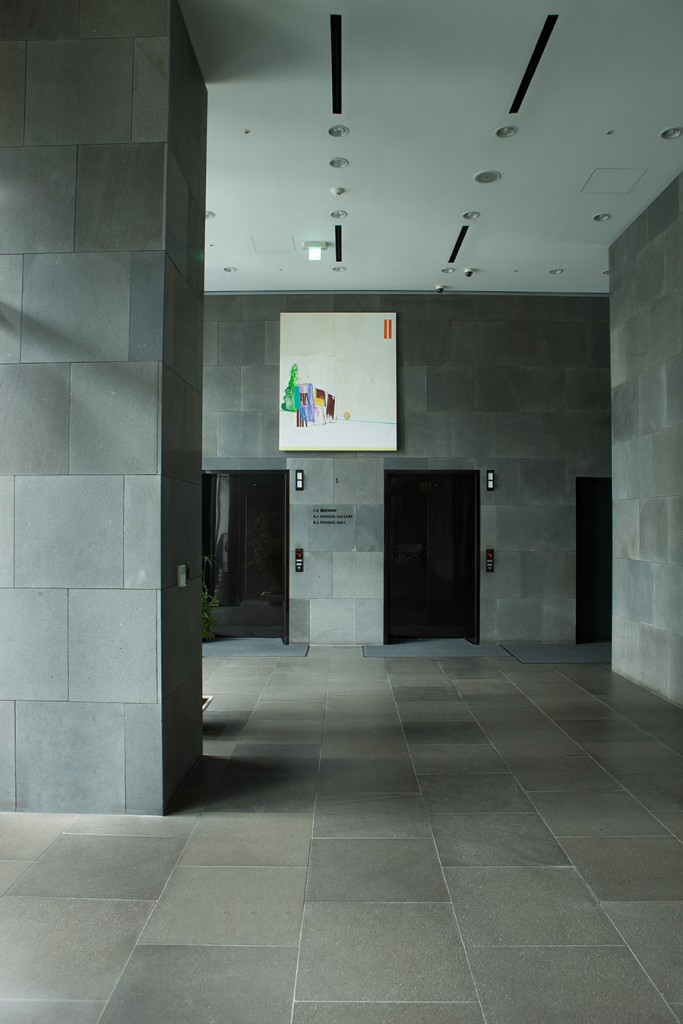Exhibitions
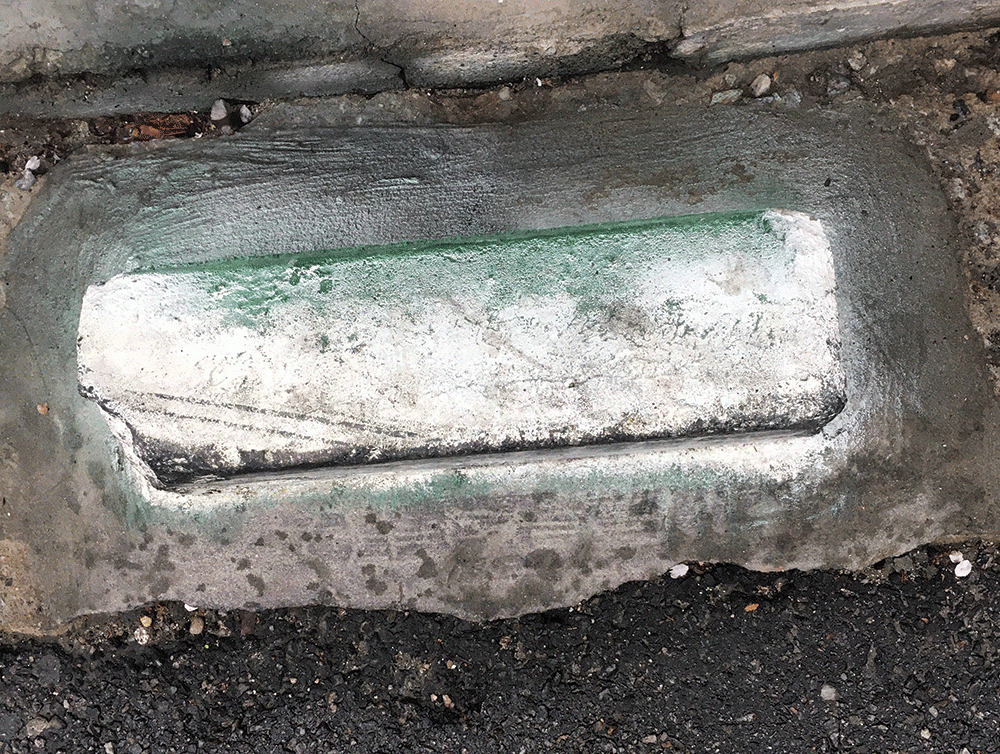
PERIGEE ARTIST #14 백현진
그 근처
2017.09.01. FRI ~
2017.11.11. SAT
<일상적인, 너무나 일상적인>
신승오(페리지갤러리 디렉터)
어떤 사람을 하나의 단어나 성격으로 규정짓는 것은 어려운 일이다. 그리고 미술, 음악, 영화 등 다양한 분야에서 활동해온 백현진 같은 예술가는 더더군다나 어렵다. 이러한 다양한 분야의 활동이 모두 모여서 하나의 백현진을 형성하겠지만, 여전히 그의 작업과 활동들은 어렴풋하게 느껴질 뿐 명확하게 손에 잡히지 않는다. 그 자신도 언젠가 필자에게 이번 전시 구성과 작품들에 대한 이야기를 하다가 ‘작업을 통해 간신히 드러낸 것을 스스로 다시 언어로 설명하는 일은 힘들다.’고 이야기 한 적이 있었다. 따라서 이 서문은 아마도 최대한 그의 작업을 정리한 글로서 그의 작업과 대척되는 지점에 존재하거나 아니면 그의 작업을 이해하는 것을 더욱 불확실하게 만들 가능성을 내포하고 있는 모호한 글이 될지도 모르겠다.
이번 글에서는 다른 예술 분야에서의 그의 활동은 일단 접어두고 미술에서의 활동만으로 한정시켜 살펴보도록 하겠다. 지금까지 회화가 주를 이루고 있는 그의 작업은 작가 자신이 살고 있는 현실의 투영이자 반영으로, 이는 눈으로 체득한 것에서부터 다양한 경험들이 붓질을 해나가는 행위를 통해 전개되어 나간다. 그리고 그는 이러한 회화작업 안에서 사소하고 평범한 일상의 감각들을 놓치지 않는....
<Ordinary, Really Ordinary>
Seung Oh Shin (Perigee Gallery Director)
It is difficult to define a person or to describe their personality with one word. Especially it is even more difficult to an artist like Hyunjin Bek who has actively worked in diverse fields like art, music, film, etc. Surely his activities in these diverse fields gather to form Hyunjin Bek but his works and activities are just vaguely felt and do not fall into the minds easily. In a conversation about the work and his plan for this exhibition, he said, “It is difficult to interpret what I represented through this work into words.” In this respect, although this introduction is my best attempt to understand his work, it exists at a point just opposite to his work or makes his work more uncertain.
This text focuses on activities of Hyunjin Bek in the field of visual art among activities in many other fields. His work is mainly painting, projecting upon and reflecting the reality that the artist sees and experiences through the touch of his brushes. He certain....
신승오(페리지갤러리 디렉터)
어떤 사람을 하나의 단어나 성격으로 규정짓는 것은 어려운 일이다. 그리고 미술, 음악, 영화 등 다양한 분야에서 활동해온 백현진 같은 예술가는 더더군다나 어렵다. 이러한 다양한 분야의 활동이 모두 모여서 하나의 백현진을 형성하겠지만, 여전히 그의 작업과 활동들은 어렴풋하게 느껴질 뿐 명확하게 손에 잡히지 않는다. 그 자신도 언젠가 필자에게 이번 전시 구성과 작품들에 대한 이야기를 하다가 ‘작업을 통해 간신히 드러낸 것을 스스로 다시 언어로 설명하는 일은 힘들다.’고 이야기 한 적이 있었다. 따라서 이 서문은 아마도 최대한 그의 작업을 정리한 글로서 그의 작업과 대척되는 지점에 존재하거나 아니면 그의 작업을 이해하는 것을 더욱 불확실하게 만들 가능성을 내포하고 있는 모호한 글이 될지도 모르겠다.
이번 글에서는 다른 예술 분야에서의 그의 활동은 일단 접어두고 미술에서의 활동만으로 한정시켜 살펴보도록 하겠다. 지금까지 회화가 주를 이루고 있는 그의 작업은 작가 자신이 살고 있는 현실의 투영이자 반영으로, 이는 눈으로 체득한 것에서부터 다양한 경험들이 붓질을 해나가는 행위를 통해 전개되어 나간다. 그리고 그는 이러한 회화작업 안에서 사소하고 평범한 일상의 감각들을 놓치지 않는다. 이는 무엇을 재현하는 식이라기 보다는 회화 자체의 회화로 그려진다. 그렇지만 그의 회화는 현실에 대한 부정적인 감정을 담아서 표현하거나 혹은 세상을 숭고하게 바라보려는 시각보다는 지극히 개인적이고 주관적인 자신에 대한 수행적인 작업처럼 보인다. 따라서 이를 사람들과 친절하고 익숙한 방식으로 공유하기 보다는 툭 던져 놓는 식이다. 다시 말하면 그에게 있어서 회화 작업은 그가 가지고 있는 모든 것을 그 어떤 매체보다 명료하게 타인에게 전달하는 수단이다. 하지만 관객에게 그의 작업은 무엇 하나에 집중하는가 싶으면 이내 흩어져 버리고, 흩어져서 사라진 듯 하면 이내 다시 눈앞에 나타난다. 말 그대로 불명확하고 모호하다.
그럼 이번 전시에서 선보이는 작품들은 어떨까? 이번 전시 타이틀은 <그 근처>이다. 이는 국립현대미술관의 ‘올해의 작가상 2017’에서 선보이는 <실직폐업이혼부채자살 휴게실>과 이란성 쌍둥이와 같은 두 편의 시에 의해서 맞물려 있다. 두 전시 모두 작가가 쓴 두 편의 시 제목을 각각 전시 명으로 사용하고 있다. <실직폐업이혼부채자살 휴게실>에 관한 글은 다른 필자가 쓰고 있으므로 그 글을 참고하면 되겠다. 우리는 <그 근처>에 대한 백현진의 시에서부터 이야기를 시작하도록 하자. 이 시를 읽어보면 매일같이 뉴스의 사회면에서 쉽게 찾아볼 수 있는 한 사람의 어른으로서의 삶을 순차적으로 나열하고 있다. 그리고 자살한 인물의 친구가 그의 장례식장에서 빠져 나와서 길을 걸으면서 벌어지는 일들과 그의 행동을 묘사하고 있다. 이러한 내용으로만 보면 신자유주의 시대를 살아가는 우리 모두의 모습이자 비참하고 지쳐버린 현실을 직접적으로 전달하는 내용으로 보인다. 그러나 작가의 말을 빌리자면 ‘시의 분위기는 내가 살아가는 남한이라는 지역의 험하고 쓸쓸한 조건을 재료로 해서 형성된다. 그 분위기는 내가 살아가는 세상의 일반적인 하나의 환경이고 나는 그것을 윤색하려는 것이 아니라 가능한 만큼 담담하게 바라보려는 것이다.' 라고 한다. 그러면 그의 시를 기억하면서 그가 말하는 세상과 작업을 이해하기 위해서 전시 구성을 살펴보도록 하자.
작가는 <그 근처> 전시에서 하나의 공간을 만들어 낸다. 이 공간에는 백현진이 만들어낸 소리가 BGM처럼 깔린다. 전시장은 포스터로 꽉 차 있다. 이는 작가가 스마트폰으로 촬영한 도시의 길바닥 이미지를 서로 다른 색상의 1도 리소 인쇄로 찍어낸 후, 반복적으로 벽에 붙였다가 떼어내는 방식으로 채워나간 것이다. 그 포스터들 위에는 컬러 스티커 형식으로 인쇄된 길바닥의 이미지가 규칙적인 듯 하면서도 불규칙하게 배치된다. 한 가지 색의 벽과 컬러로 인쇄된 사진은 대비되어 컬러의 길바닥 사진이 두드러지지만, 이들은 별 차이 없는 똑 같은 평면이자 서로 다르지 않은 길바닥 사진이다. 오랜 기간 동안 이 길 저 길을 걸으면서 담아낸 사진 작업에는 익명적인 도시의 공간과 시간이 담겨 있다. 그리고 그 길바닥에는 작가와도 상관없는 도시의 흔적들이 겹겹이 쌓여 하나의 바닥을 이루고 있고, 이는 작가의 회화작업과 같이 평면적이다. 이렇게 백현진 이 사진에 담아낸 도시에서 흔하게 발견되는 길 바닥 작업은 우연히 시작된 것인지 의도적으로 시작된 것인지 불분명하지만, 예술가라는 전문성을 가진 접근이라기 보다는 비전문적인 접근에 가깝게 보인다. 그는 이번 전시 이전부터 이미 사진들을 SNS에 꾸준히 올리면서 다른 사람들과 공유하였다. 이는 예술가로서의 접근을 드러내기보다는 비전문가적인 일탈을 가져온다. 그리고 이러한 일상적인 것들을 사진으로 담아내어 SNS로 공유하기를 반복 하는 과정 속에서 작가로서의 특별한 삶이 드러나기 보다는 백현진이라는 자신의 인생을 사는 것에 대한 욕망이 담담하게 분출되는 것처럼 보인다. 따라서 그가 살아가는 세상 속에서 작가는 이 현실의 더럽고, 조야함을 있는 그대로를 받아들이기 위한 체념한 듯한 표면을 가진 길 바닥의 사진들 속에서, 아직은 잠자고 있는 꿈틀대고 있는 그 어떤 힘을 본 것인지도 모르겠다.
다음은 영상작업으로 넘어가 보자. 전시장 한 벽에는 두 개의 영상이 설치되어 있다. 두 영상 모두 사운드 없이 담담하게 이미지를 보여주고 있다. 하나는 바람에 의해 흔들리는 나무를 찍었다. 요즘 흔히들 찍듯이 스마트폰으로 촬영되었고, 작가의 시선이 나무에 고정된 채 감정 없이 바라본 그대로의 기록이다. 그런데 화면을 보면 볼수록 의문이 드는 것은 작가가 바람을 찍으려 한 건지 바람에 흔들리는 나무를 찍으려고 한 건지 불분명하다는 점이다. 그럼에도 불구하고 굳이 이유를 추축해 본다면 백현진은 눈에 보이지 않는 영향에 의해 흔들리면서도 굳건한 나무에 한 순간 매료된 것은 아니었을까? 또 하나의 작업은 작가가 등장하는 술집의 CCTV의 화면이다. 술에 취해 졸다가 테이블에 촛불로 인해 머리에 불이 붙는 헤프닝을 담은 영상은 작가의 무의식적인 행동에서 벌어지는 사건이 CCTV라는 감정 없는 기계를 통해 그대로 나타난다. 그가 이 영상을 작업으로 취한 것은 일상 속에 ‘나’를 ‘나’의 외부로 나와서 바라보는 유체이탈을 한 것 같은 묘한 순간이 담겨 있기 때문에 선택한 것은 아닐까? 이 외에도 1층 로비에 전시되고 있는 영상은 작가가 클럽에 놀러 갔을 때 몰래 촬영한 지인의 춤추는 두 발이다. 바닥에 스텝을 밟으면서 움직이는 두 발은 순간 공중에 떠 있는 것처럼 부드럽고 유연한 동작들로 바닥이라는 건 전혀 느낄 수 없는 마치 무중력의 공간을 보여준다. 이는 아마도 춤추는 지인을 보면서 스스로의 자유를 위해 기존의 시스템에서 무작정 일탈하는 것이 아니라 시스템과는 다른 ‘나’의 생각과 감정, 취향을 기존의 것들과 동일 선상에서 놓고 어느 한쪽을 철저하게 배제하지 않으려고 노력할 때 획득되는 진정으로 자유롭게 떠오르는 가벼운 몸을 발견한 것일지도 모른다. 그러나 이 모든 해석을 위한 번잡한 글보다 영상작업들에서 중요한 것은 작가로서 그가 무엇을 담아 냈는지가 아니라 어떻게 그것을 담아내는 지이다. 그것은 그가 일상을 살아가면서 의도되지 않은 순간에 이 모든 것을 담아내었다는 사실이며, 또한 그 작업의 발화점도 명확하지 않다는 사실 일 것이다. 그리고 그 증거로 작가는 영상작업을 위해 일부러 어딘가를 찾아다니면서 촬영을 한 적도 있었지만 모두 만족스러운 결과를 내지 못하였다는 사실을 덧붙인다.
그러면 이제는 마지막으로 1층 로비에 걸려 있는 회화 작업으로 되돌아 와서 백현진이 살고 있는 세상은 어떤 곳이며, 그는 그 세상을 어떤 태도로 살아가는지에 대한 이야기로 글을 마무리해보자. 위에서 살펴 본대로라면 그는 예술보다는 일상이라는 길에서 목적 없이 어디론가 배회하는 산책자로서 아무 것도 하지 않으면서 그저 길을 걸을 뿐이다. 그렇다면 지금까지의 회화작업에서 그가 끊임없이 붓질을 가하면서 지속적으로 추구하는 회화 그 자체의 평면성을 유지하기를 바랐던 것은, 이번 전시에서 드러나듯이 그저 그리는 것 외에는 아무것도 하지 않음에 다다르고자 하는 바람은 아니었을까? 그러기에 <그 근처>의 시처럼 그는 어느 순간 이유도 모르는 채 멈춰 서서 밑도 끝도 없이 일상 속에서 그 무엇인가를 보고 있었는지도 모르겠다. 그리고 이러한 태도들은 다양한 장르를 넘나드는 활동을 해오면서 점점 멀어지는 백현진이라는 자신을 놓치지 않기 위한 방법인 것처럼 보인다. 다시 말하면 아무것도 하지 않음은 예술가 혹은 음악가, 배우라고 명명된 존재에서 발생되는 작업에서 머무르지 않고 동시에 백현진이라는 자신에게서 스스로 일어서기를 바라는 행위이다. 이는 자신을 제외한 외적인 틀로 인한 시작점에서는 아무것도 하지 않음을 말한다. 이렇게 예술가로서 아무것도 하지 않음의 태도는 오히려 일상에서의 백현진 그 자체로 순수한 잠재력과 그 무엇이 될 가능성으로 충만한 상태로 향하는 길이 된다.
결국 지금까지 살펴본 것들은 백현진이 일상 속에서 끊임없이 순응과 저항을 통해 변해가는 ‘나’를 있는 그대로 작업으로 담아내는 그의 예술 행위의 가장 최근의 버전이다. 이를 통해 백현진이 살고 있는 세상은 어떤 것이 ‘있는’ 것으로 주어진 것이 아니라 세상을 그 어떤 것으로 주관적으로 ‘본다’라는 행위로 이루어진 세상임을 알 수 있다. 필자는 글을 써나가면서 그의 작업을 텍스트라는 고정된 틀로 담아내려는 부질없는 짓을 하고 있다는 생각을 지울 수가 없다. 하지만 처음에 글을 시작할 때 미리 언급하였듯이 아마도 그의 작업의 대척점에 위치하거나 작업을 이해하는 것을 더욱 모호하게 만드는 두 가지의 상반되는 역할에 동시에 충실하면서, 위에서 살펴본 백현진의 일상적인 예술 행위를 어느 정도 도드라지게 보여줄 수 있을 것이라 믿으며, 스스로 위안을 삼아 본다.
Seung Oh Shin (Perigee Gallery Director)
It is difficult to define a person or to describe their personality with one word. Especially it is even more difficult to an artist like Hyunjin Bek who has actively worked in diverse fields like art, music, film, etc. Surely his activities in these diverse fields gather to form Hyunjin Bek but his works and activities are just vaguely felt and do not fall into the minds easily. In a conversation about the work and his plan for this exhibition, he said, “It is difficult to interpret what I represented through this work into words.” In this respect, although this introduction is my best attempt to understand his work, it exists at a point just opposite to his work or makes his work more uncertain.
This text focuses on activities of Hyunjin Bek in the field of visual art among activities in many other fields. His work is mainly painting, projecting upon and reflecting the reality that the artist sees and experiences through the touch of his brushes. He certainly does not miss the insignificant and ordinary sense of everyday life in his painting. However, his painting is not about representing certain images but more about painting for painting’s sake. He does not express a negative or sublime viewpoint on reality in his painting but rather some personal and subjective ideas, so that his painting almost looks like a practice for self-realization. Thus, his way of communication can be seen as not a familiar explanation but as a trigger, thrown by his work. In other words, the medium of painting to Hyunjin Bek is a means of clearly delivering what he has inside him more than any other medium. Yet - to audiences - his work scatters when they try to focus on one thing, and appears again when focus is scattered. His work is literally unclear and vague.
What is his work in this exhibition like? The title of this exhibition is In the Neighborhood. It is related to the work, UnemploymentBankruptcyDivorceDebtSuicide Rest Stop - that will be shown for the Korea Artist Prize 2017, in the National Museum of Modern and Contemporary Art- with two poems like a binocular twin. The title of both exhibitions uses the title of poems that the artist wrote. There is a text about UnemploymentBankruptcyDivorceDebtSuicide Rest Stop by another critic, so that you can refer to it if there is any interest. This text focuses on In the Neighborhood by starting from the artist’s poems. The poem describes the life of an adult in sequence - who can easily be found in the general newspapers - and depicts events and activities of a friend of a person who committed suicide while he walks on the street after the funeral. The story may seem to be portrayed as being in the era of neoliberalism, and directly tells about today’s miserable and tired reality. However, the artist says, “The general atmosphere of the poems is formed by the rough and lonesome conditions of life in South Korea. This atmosphere is a general environment in the world, and I try not to embellish it, but look at it with a disinterested attitude.” Let us examine the composition of the exhibition to understand the world he talks about and his work.
The artist creates a space in the exhibition In the Neighborhood. In this space, a sound by the artist is played like background music. The exhibition space is filled with posters. These are images of streets, taken by the artist with a smartphone and printed in different single colors of lithography. On top of them, images of streets printed as a sticker form are placed in a repetitive but irregular way. Although different colors of the printed images of the streets are distinct from each other, these are similarly assembled images that are not much different from each other. In the images of streets that the artist took over a long period of time, anonymous space and the times of the city are unveiled. The streets contain layers of traces that do not directly relate to the artist as similar to the artist’s flat painting. We cannot be sure if the images are captured with or without intention but we surely see that there are unprofessional approaches in the process. The artist has shared these images on SNS before this exhibition. It was initiated less as an artist but as a outpouring from an artist. This act – that captures and shares insignificant matters in images through SNS - seems to express a desire for living as who he is rather than showing any special life as an artist. Perhaps the artist has seen a certain power that has been sleeping and waiting for its time in the images of streets, although they seem to give a sigh of resignation by adapting dirty and raunchy reality as it is.
Two video works are installed in one corner of the exhibition space. Both of them show without sound but only images in silence. One captures a tree shaken by the wind. It was filmed by a smartphone like many people do these days, and it is a documentation of a moving tree just as it was without any feeling. However, as you become to watch more and more, the strange thing of the video is that we are unsure whether the artist attempted to capture the wind or the movement of a tree. If I have to guess the reason, nevertheless, perhaps the artist is fascinated by a tree, standing straight even if it is shaken by unseen influences. Another single channel video from the CCTV is of a bar with the artist in it, showing how his hair was burnt from candlelight when doused with alcohol. The emotionless machine, CCTV, captures this unintentional behavior. I wonder if the artist used this film in order to present the moment that he came to see himself from the outside, like an out-of-body experience. The video in the lobby on the first floor of the gallery captures the feet of his dancing friend in the club without telling him. The movement of the two feet touching the floor is so soft and flexible that they seem like floating in the air in a weightless space. From this light body, the artist may realize that freedom is achieved by not excluding anything: putting one’s thoughts, feelings, and preferences on the same level, even if they are different from the existing system rather than escaping from it. For the interpretation of those moving images, however, the importance should not be in a complicated text or what he captured, but in how he captured them. It shows that he captured those moments without intention in everyday life, and thus, a starting point is not clear at all. As evidence, the artist mentions that he did not find any satisfaction when he traveled to find a subject to film.
Lastly, the painting in the lobby on the ground floor would be a good example to talk about what kind of the world Hyunjin Bek lives in, and what kind attitudes he has in that world. As mentioned above, he likes to roam in everyday life without any purpose, and follows his path just as a flâneur. Can it be said that the way he tries to maintain the flatness of painting while he keeps making stokes on canvas is refer to his desire to do nothing other than painting for its sake? Then, the reason he has continued his own way - painting on a flat surface - could represent his wish to paint and do nothing else beyond this. Like in the poem In the Neighborhood, the artist might stop in the middle without realizing a reason, and see something in ordinary everyday life. This attitude might be his way of not missing himself at the time when he has tried to cross over in diverse genres. In other words, “doing nothing,” does not mean the same as a job defined by the society as an artist, musician, or actor, but triggers the artist to be wakened. It shows that nothing can be started from a point exists as an exterior frame without himself. This attitude leads him to stay within pure potentiality and the possibility to be able to become something.
Finally, what we describe in this text is the most recent version of his art practice that captures changing ‘me’ from continuous adaptation and resistance to everyday life as it is. By seeing this, we begin to know that the artist does not see the world with something in it but he believes that the world exists from his action of seeing. I keep thinking that writing about his work in a fixed text is very vain. As I mentioned in the beginning, my text is working as two contrasting roles - standing at the opposite point of his work while making his work vague, but also emphasize Bek’s artistic activities in his daily life- and I still hope it can be seen as an attempt to understand his practice a little more.



